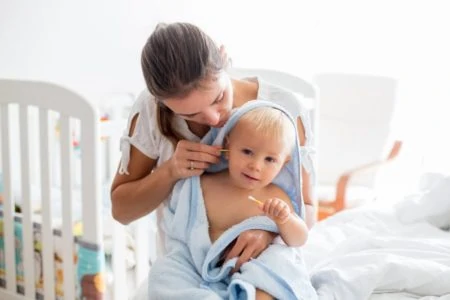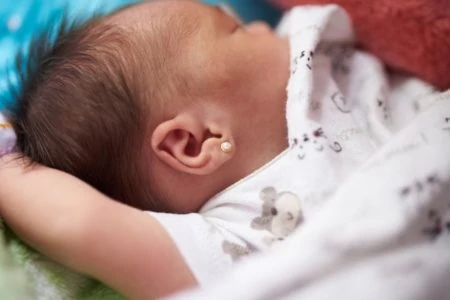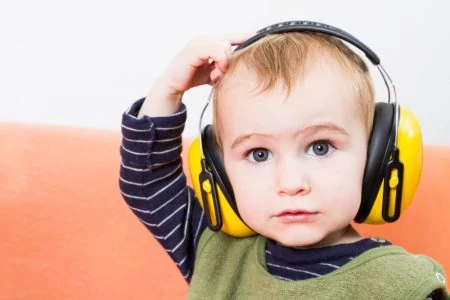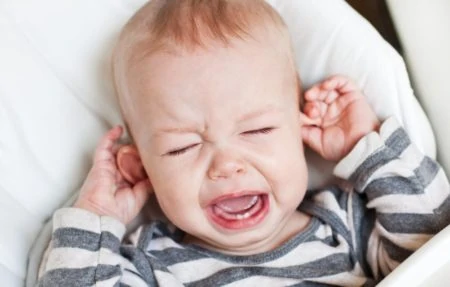Babies produce earwax just like adults, but their tiny ears require a much gentler approach. Using the wrong tools can actually push the wax deeper or cause damage.
We’ll break down everything you need to know about baby earwax, how to clean those adorable ears safely, and when you should call the pediatrician.
Key Takeaways
- Earwax (cerumen) is a healthy, natural substance that protects and moisturizes the ear canal; it is rarely a sign of poor hygiene.
- The safest way to clean a baby’s ears is wiping the outer ear with a soft, warm washcloth.
- Never insert cotton swabs, fingers, or pointed objects into the ear canal, as this can damage the eardrum or cause wax impaction.
- Consult a pediatrician if your baby pulls at their ears, has a fever, or if you see fluid drainage that looks like pus or blood.
What Is Earwax?
Earwax, medically known as cerumen, is a sticky substance produced by glands inside the ear canal. It is a mix of dead skin cells, hair, and secretions from the ceruminous glands (1).
While it might look gross to us, it serves a vital purpose. In babies, earwax is often softer and lighter than the dense, dark wax adults produce.
You might see colors ranging from light yellow to dark orange or brown. This is normal. The wax typically dries up and migrates out of the ear on its own, bringing trapped dust and dirt with it.
Sometimes, a baby’s ears produce more wax than usual. This buildup can also happen if a parent accidentally pushes wax deeper into the canal while trying to clean it. If this blockage sits for too long, it can temporarily affect hearing or cause mild irritation.
Why Do Babies Have Earwax?
Think of earwax as the body’s natural security system for the ears. It is sticky for a reason. It traps dust, dirt, and foreign particles before they can travel down the ear canal and damage the eardrum (2).
Beyond acting as a physical barrier, earwax has chemical properties that help fight off bacteria and fungi. It keeps the ear canal healthy and prevents infections.
Additionally, earwax acts as a moisturizer. Without it, the delicate skin inside the ear canal would become dry, itchy, and prone to irritation.
How Much Earwax Is Normal?
There is no set standard for “normal” earwax volume. Some babies are simply wax-factories, while others produce very little. It is also common for one ear to produce more than the other.
If you can see into the ear canal past the wax, there is usually no issue. However, if the wax completely blocks the view of the eardrum, your pediatrician might suggest using specific drops to soften it.
Unless your baby seems uncomfortable or is failing to respond to sounds, the amount of wax is rarely a medical concern.
How to Clean Your Baby’s Ears Safely
When it comes to baby ears, the rule is simple: less is more. The ear is a self-cleaning organ, and interfering too much can cause more harm than good.
- Don’t use Q-tips: Cotton swabs are the enemy of healthy baby ears. They are shaped perfectly to push wax deeper against the eardrum, leading to impaction. The friction can also scrape the sensitive skin inside the canal, leading to infection.
- Don’t use fingers: Even your pinky is too large for a baby’s ear canal. Fingernails can scratch the skin, and you risk introducing new bacteria into the ear.
- Don’t overclean: You need some wax for protection. removing too much can leave the ear dry and itchy.
The Washcloth Method
Most pediatricians agree that the washcloth method is the gold standard for hygiene. It is effective, safe, and easy.
This technique focuses on the outer ear only. You are wiping away the old wax that the body has already expelled.
Here is how to do it:
- Prepare the cloth: Use a soft washcloth dampened with warm (not hot) water. You do not need soap.
- Wring it out: Squeeze out excess water. You do not want water dripping into the canal, as moisture can get trapped and encourage bacteria growth.
- Wipe gently: Run the cloth around the outer shell of the ear and behind the ear. Wipe away any visible wax or crustiness from the opening, but do not poke your finger inside.
- Dry the area: Pat the ear dry with a soft towel.
Is It Earwax or an Ear Infection?
Ear infections (otitis media) are incredibly common. They happen when fluid gets trapped behind the eardrum, creating a breeding ground for bacteria or viruses.
Because babies have shorter, more horizontal eustachian tubes than adults, drainage is difficult. This makes them highly susceptible to infections, especially before their third birthday (3).
Distinguishing between a harmless wax buildup and a painful infection can be tricky. Both might cause a baby to mess with their ears.
Ear infections are more common in infants and toddlers because the connection between the nasal cavity and middle ear (eustachian tube) is horizontal, allowing any nasal fluid to pass through easily. As kids grow, the skull elongates and creates a more vertical connection, preventing the backflow of congestion (4).
Editor's Note:
Dr. Leah Alexander, MD, FAAPWatch for these symptoms to spot an infection:
- Changes in mood: Increased fussiness, crying more than usual, or clinginess.
- Sleep regression: Trouble falling asleep or waking up crying due to pressure changes in the ear when lying down.
- Fever: A temperature of 100.4°F (38°C) or higher often accompanies infections.
- Drainage: Look for fluid that is milky, clear, or bloody. This is different from sticky, colored earwax.
- Balance issues: Clumsiness or unsteadiness can indicate fluid imbalance in the middle ear.
- Reduced hearing: Lack of response to quiet noises or voices.
Common Causes of Ear Infections
Dirt does not typically cause ear infections. The real culprit is usually a prior illness.
Infections often strike after a cold, flu, or throat infection (5). The congestion from the respiratory illness blocks the eustachian tubes, trapping fluid in the middle ear. Bacteria love this warm, damp environment and multiply quickly, causing inflammation and pain.
Visual Check: Wax vs. Infection
If you are unsure, grab a flashlight and take a gentle look. Pull the earlobe slightly back and down to open the view.
- Earwax: Looks like a solid or semi-solid substance. It is usually yellow, orange, or brown. It sits in the canal.
- Infected discharge: Looks liquidy or pus-like. It might be white, clear, or green, and sometimes smells bad. If you see blood or pus draining, call the doctor immediately, as this could indicate a ruptured eardrum.
FAQs on Cleaning Baby Ears
In Conclusion
Earwax is not the most glamorous part of parenting, but it plays a crucial role in keeping your baby’s ears healthy.Remember that a little wax is normal and even beneficial. Avoid the temptation to over-clean, and definitely hide the cotton swabs. A simple wipe with a warm washcloth during bath time is usually all you need.
If you ever notice foul smells, discharge, or if your baby seems to be in pain, give your pediatrician a call.









